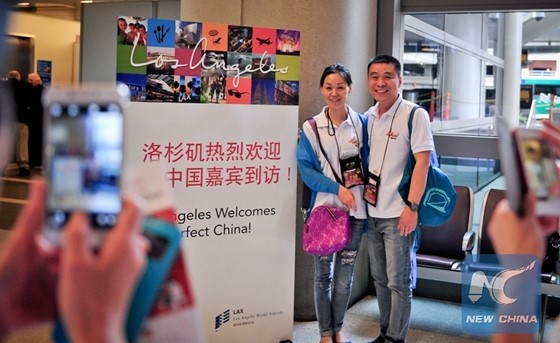China a tourism game-changer for LAC
- By Earl Bousquet
 0 Comment(s)
0 Comment(s) Print
Print E-mail China.org.cn, August 18, 2017
E-mail China.org.cn, August 18, 2017
|
|
|
File photo taken on May 22, 2014 shows two happy Chinese tourists at Los Angeles International Airport. [Photo/Xinhua] |
Chinese visitors spent more dollars in the United States in 2016 than tourists from other countries. According to the U.S. Commerce Department, 2.97 million Chinese visited the U.S. in 2016 and spent $33 billion, the two figures going up by 15 percent and 9 percent respectively from 2015.
China is also the Number One market for U.S. tourism "exports," injecting more than $90 million a day into the U.S. economy.
With an estimated 3.5 million Chinese expected to visit the U.S. by the end of 2017 and the total expected to exceed 5 million in 2021, Latin American and Caribbean (LAC) governments and tourism authorities have been furiously scratching their heads, trying to figure out how best to equally attract Chinese holiday makers.
As neighboring regions with shared and different histories featuring both continental and island tourism attractions, the two LAC geographic regions have had both common and different experiences in tourism growth.
Most Caribbean tourism is island-based and (with a few exceptions like the world-famous Jamaica-owned Sandals International brand) top facilities are mainly American or European owned, with visitors sourced mainly from neighboring North America (USA and Canada) and European states with historical connections.
In Latin America, on the other hand, Spanish, Italian and other selected countries (also with historical imperial and colonial roots in the region) also own significant tourism investments.
North America and Europe have quickly adjusted their national, regional and continental policies to attract the increasing number of Chinese visitors now venturing beyond Asian skies and shores.
However, both sides of the LAC region have lapsed in tailoring their tourism products to suit the lucrative Chinese source market. Like everywhere else, each continental state and island nation has something unique to offer. The problem, however, has been identifying that unique product and showing it to the world.
Now, government and private tourism interests in the wider LAC region have been offered direct access to Beijing's thinking on how best to go about the business of better shaping their tourism product offerings, with their eyes on the Chinese market today.
Beijing issued its "Policy Paper on Latin America and the Caribbean" at the end of last year, in which it outlines, for the very first time and in detail, what can be done together by governments and tourism authorities "on both sides."
The paper identifies practical mutual possibilities that answer many of the questions occupying the minds of tourism planners - particularly in the Caribbean, where Chinese visitor travel is still relatively low.
Current travel infrastructure doesn't yet facilitate easy Chinese access to the most popular Caribbean destinations, as visa requirements, airport travel status, language and cultural adjustments have not yet been adequately made.
The LAC region's excessive historical reliance and near-total dependence on visitors from similar traditional sources has also severely limited the speed with which some of the existing tourism entities are willing to open their floodgates to the Chinese market.
Then there's that part of the equation that has almost always been overlooked: Latin American and Caribbean visitors to China.
China's maturing tourism product is being continuously developed and now extends far beyond the Olympic Bird's Nest, the Forbidden Palace, the Great Wall or other similar Beijing-based attractions.
A weekend cruise on the Yangtze River is as adventurous as exploring the full variety of raw spices in Sichuan Province, elevating silently at breakneck speed up the Oriental Tower in Shanghai, riding a quiet suspended Maglev bullet-train, or visiting the ever-changing Planning Exhibition Halls in Beijing, Shanghai or Xiamen.
It will take time to develop China tourism tours to the LAC region in volumes currently being experienced by Europe and North America - and vice versa.
But Beijing has thrown out a lifeline in its position paper which, if acted upon early, in earnest and sincerity, can see Chinese visitors flock to the LAC regions in volumes that will not only quench the growing thirst for more, but also develop and share new and more sustainable tourism products that will also attract and encourage more Latin American and Caribbean visitors to China.
Earl Bousquet is a contributor to china.org.cn, editor-at-large of The Diplomatic Courier and author of an online regional newspaper column entitled Chronicles of a Chronic Caribbean Chronicler.
Opinion articles reflect the views of their authors, not necessarily those of China.org.cn.






